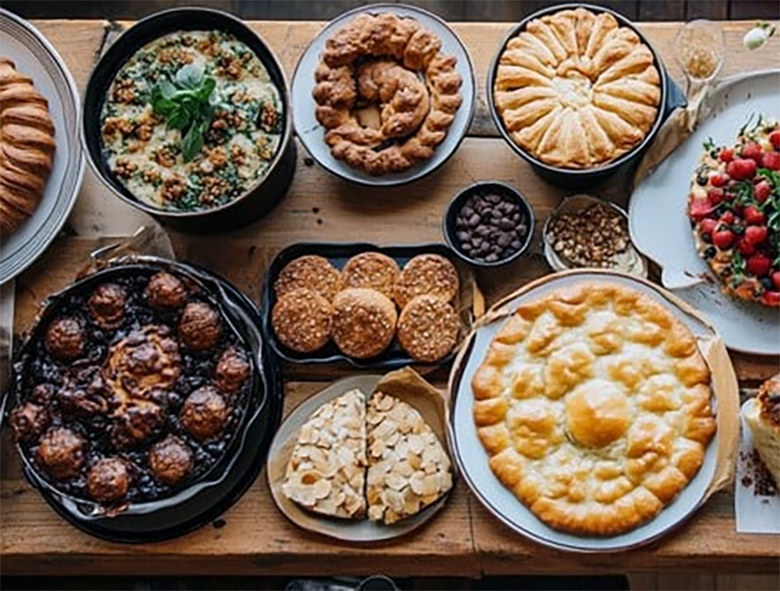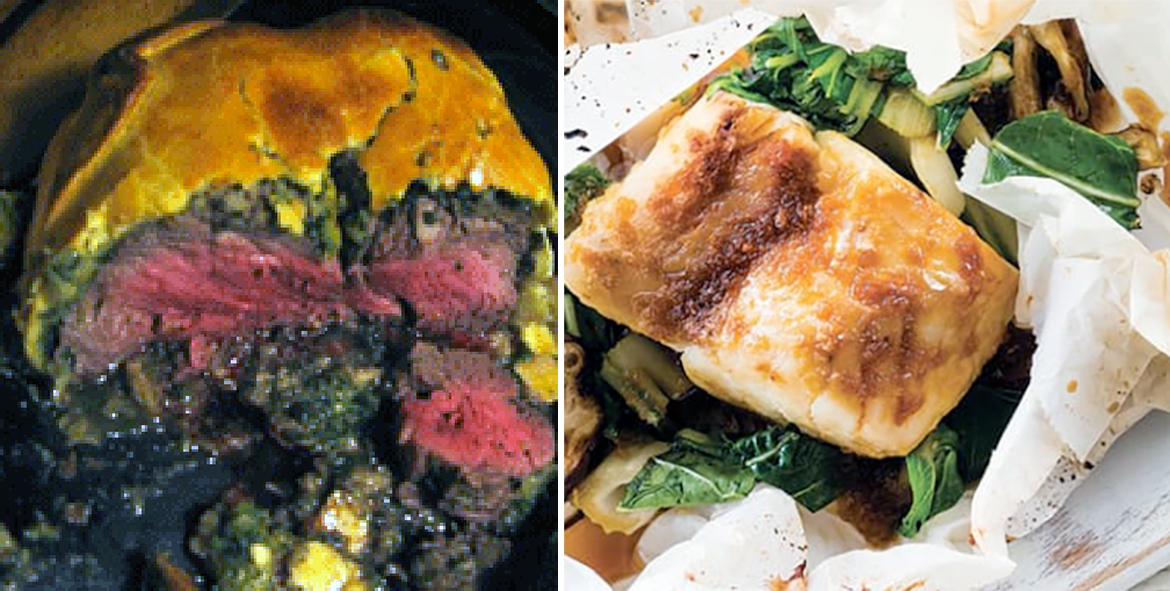FabulousFusionFood's Baking Recipes 19th Page
 A range of baked goods.
A range of baked goods.
Welcome to FabulousFusionFood's Baking Recipes Page — This is a continuation of an entire series of pages that will, I hope, allow my visitors to better navigate this site. As well as displaying recipes by name, country and region of origin I am now planning a whole series of pages where recipes can be located by meal type and main ingredient. This page gives a listing of all the baking recipes added to this site. Baking is defined as a technique for the prolonged cooking of food using dry heat by the action of conduction. Baking is normally done in an oven, but goods may also be baked in hot ashes or on hot stones. Baking differs from Roasting Recipes in that a lower temperature is typically used and the items are cooked for a longer period of time. Baking is a much older process than most people think and foods were probably originally baked in embers or with hot stones (which is how bread may have started). Only later did specialist ovens develop. Though most baked goods tend to be bread or cake-based some other dishes such as pasta dishes and vegetable dishes may also be baked. Stews are often also technically baked in an oven, but are not classed as 'baked goods' in that they are more liquid than solid at the end of the cooking process.
Baking is a method of preparing food that uses dry heat, typically in an oven, but can also be done in hot ashes, or on hot stones. The most common baked item is bread, but many other types of foods can be baked. Heat is gradually transferred "from the surface of cakes, biscuits and cookies, and pieces of bread to their centre, typically conducted at elevated temperatures surpassing 150°C. Dry heat cooking imparts a distinctive richness to foods through the processes of caramelization and surface browning. As heat travels through, it transforms batters and doughs into baked goods and more with a firm dry crust and a softer centre. Baking can be combined with grilling to produce a hybrid barbecue variant by using both methods simultaneously, or one after the other. Baking is related to barbecuing because the concept of the masonry oven is similar to that of a smoke pit.
In addition to bread, baking is used to prepare cakes, pastries, pies, tarts, quiches, biscuits and cookies, scones, crackers, pretzels, and more. These popular items are known collectively as 'baked goods', and are often sold at a bakery, which is a store that carries only baked goods, or at markets, grocery stores, farmers markets or through other venues.
 Beef en croûte (left) and fish en papillote (right).
Beef en croûte (left) and fish en papillote (right).
The alphabetical list of all the baking recipes on this site follows, (limited to 100 recipes per page). There are 2282 recipes in total:
Page 19 of 23
| Rum and Chocolate Cupcakes Origin: Britain | Scone and Butter Pudding Origin: Scotland | Sgoniau Mam (Mum's Batch Scone) Origin: Welsh |
| Rum And Coconut Bread Pudding Origin: Cayman Islands | Scone Pizza Base Origin: Italy | Sgoniau Melys (Sweet Scones) Origin: Welsh |
| Rum Raisin Cheesecake Origin: Britain | Scones Origin: Scotland | Sgoniau Sawrus (Savoury Scones) Origin: Welsh |
| Rwlâd Bara Lawr (Laverbread Roulade) Origin: Welsh | Scotch Cake Biscuits Origin: Scotland | Sgoniau Triog (Treacle Scones) Origin: Welsh |
| Saba Spice Cake Origin: Saba | Scotch Pie Origin: Scotland | Shami Kebab Origin: India |
| Sabaayad (Somali Flatbread) Origin: Somalia | Scots Mutton Pies Origin: Scotland | Shamrock Sugar Biscuits Origin: Ireland |
| Sablés Bretons (Breton Biscuits) Origin: France | Scottish Bacon and Potato Pie Origin: Scotland | Shellbread Origin: Britain |
| Sablés Bretons Maison (Home-made Breton Shortbread) Origin: France | Scottish Baps Origin: Scotland | Shellfish and Leek Roly-poly Origin: Britain |
| Saboera Biscuits Origin: South Africa | Scottish Christmas Bun Origin: Scotland | Shepherd's Pie Origin: Britain |
| Sachertorte Origin: Austria | Scottish Fruit Tart with Whisky Origin: Scotland | Sheqerpare (Biscuits in Syrup) Origin: Albania |
| Safra (Semolina and Date Cake) Origin: Libya | Scottish Lace Biscuits Origin: Scotland | Shetland Shortbread Origin: Scotland |
| Sagu Keju (Indonesian Cheese Biscuits) Origin: Indonesia | Scottish Marmalade Bread and Butter Pudding Origin: Scotland | Ship's Biscuit Origin: Britain |
| Saint Helena Coconut Rock Cakes Origin: St Helena | Scottish Oatcakes Origin: Scotland | Short Cakes Origin: Britain |
| Saint Helena Curry Puffs Origin: St Helena | Scottish Parkin Origin: Scotland | Shortbread Oatmeal Biscuits Origin: Scotland |
| Saint Helena Ginger Beer Origin: St Helena | Scottish Parkin with Lemon Sauce Origin: Scotland | Shortcrust Pastry Dough Origin: British |
| Saint Helena Rock Cakes Origin: St Helena | Scottish Parliament Cakes Origin: Scotland | Shropshire Cakes Origin: England |
| Saint Patrick's Cakes Origin: Ireland | Scottish Pickled Herring Origin: Scotland | Siberian Bird Cherry Cake Origin: Russia |
| Saint Vincent Black Cake Origin: Saint Vincent | Scottish Shortbread Origin: Scotland | Sicilian Lemon Polenta Cake Origin: Italy |
| Salara Origin: Guyana | Scottish Snowballs Origin: Scotland | Sierra Leonean Rice Bread Origin: Sierra Leone |
| Salara Cake Origin: French Guiana | Scottish Steak Pie Origin: Scotland | Simnel Cake Origin: England |
| Salmon and Couscous en Papillote Origin: British | Scottish Venison Pie Origin: Scotland | Simnel Cake 2 Origin: British |
| Salted Caramel Cheesecake Origin: Britain | Sea-buckthorn Cheesecake Origin: Britain | Simnel Cupcakes Origin: British |
| Salted Pilchard and Leek Pie Origin: Britain | Seasoning Pudding Origin: Manx | Single-layer Calabrian Pizza Origin: Italy |
| Sambocade (Elderflower Cheesecake) Origin: England | Seaweed Flour Biscuits Origin: Britain | Siphnopitta (Honey and Cheese Cake) Origin: Greece |
| Sanddorn-Muffin (Sea-buckthorn Muffins) Origin: Germany | Seaweed Wolfberry Cupcakes Origin: Britain | Sirnica (Dalmatian Easter bread) Origin: Croatia |
| Saniyit Kufta (Baked Beef Patties) Origin: Egypt | Selkirk Bannock Origin: Scotland | Siwin (Sewin) Origin: Welsh |
| Sara Lee Pound Cake Origin: American | Sernik Krakowski (Polish Lattice Cheesecake) Origin: Poland | Sloppy Joe Pizza Origin: American |
| Sausage Lattice Origin: Northern Ireland | Serviceberry Muffins Origin: Canada | Small Raised Mutton Pies Origin: Scotland |
| Sausage Rolls Origin: Britain | Sevillum (Sweetened Cheese Dough) Origin: Roman | Smetanniki (Belorussian Sour Cream Buns) Origin: Belarus |
| Savillum (Cheese Bread) Origin: Roman | Sewin Gyda Saws Perlysiau (Sea Trout with Herb Sauce) Origin: Welsh | Smoked Chicken, Leek and Mushroom Pie Origin: Australia |
| Savoury Potato Roulade Origin: Ireland | Sex Muffins (Sex Muffins) Origin: Australia | Snowball Cakes Origin: Britain |
| Sawine (Trini Sweet Baked Noodles) Origin: Trinidad | Sgoniau Bricyll a Chnau Ffrengig (Apricot and Walnut Scones) Origin: Welsh | Snowflake Cake Origin: America |
| Scallop and Mushroom Pie Origin: Ireland | Sgoniau Caerffili (Caerphilly Scones) Origin: Welsh | |
| Schenecken (Crispy Butterhorns) Origin: Germany | Sgoniau Ceirios (Cherry Scones) Origin: Welsh |
Page 19 of 23